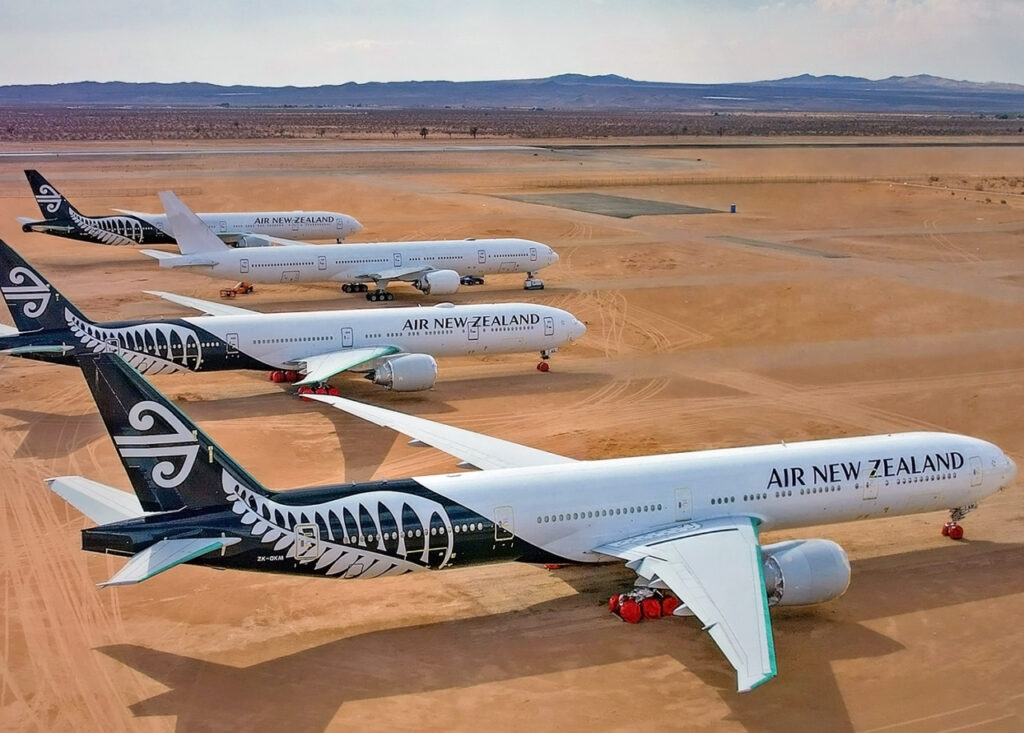After an 885-day stint of dormancy, baking in the Mojave Desert, Air New Zealand’s final Boeing 777-300 is returning to New Zealand.
The aircraft, registered ZK-OKM, is the last of the New Zealand national carrier’s fleet of seven Boeing 777-300 aircraft which were mothballed in the Californian desert during the global pandemic downturn.
According to Planespotter’s data, the airframe, a 12.5-year-old Boeing 300ER, was stored at the California desert Victorville location from 27 Nov 2020 – 1 Apr 2023. It was then re-located to Singapore Changi.

In a statement to media reported by local news source 1News, Air New Zealand’s chief operations officer, Alex Marren, described the long and exacting process involved to “reanimate” the mothballed aircraft.
“The reanimation of OKM alone has taken more than seven weeks and involved more than 1500 manhours of work,” Marren said.
“The process starts off with unwrapping the plane from its storage protection, and then it gets a good wash, getting rid of the dust and grime that has accumulated in the desert.
“Then it goes through a thorough servicing and maintenance programme. It’s a long and complicated process, and our engineering and maintenance team have done an amazing job getting the aircraft ready to fly again.”
“Overall, a team of more 100 Air New Zealanders have been involved in bringing back these 777 aircrafts in some way.”
[monsterinsights_popular_posts_inline]
With the strong rebound in air travel demand showing no sign of abating, the final Boeing 777 is scheduled to return to commercial operations this coming weekend.
“Having all of our 777-300s back will help build more resilience and more seats into our international operation, meaning we can fly more customers to where they need to go – whether that’s San Francisco, Honolulu, Houston or Tahiti,” says Marren.
Storage in the Mojave
Commercial aircraft are stored in the Mojave Desert, particularly at places like the Mojave Air and Space Port in California, for several reasons.
The dry climate of the desert helps prevent corrosion and damage to the aircraft’s structure and components, as it has low humidity and reduces the risk of moisture-related issues.
Whilst this is typically seen by most people as the primary factor for storage in the desert location, there are several other key benefits which favour the location.
Logistically, the wide-open spaces in the Mojave Desert allow for efficient parking and manoeuvring of the aircraft, with extensive tarmacs and parking areas available.
The land value in this region is relatively lower compared to urban areas, making it cost-effective for airlines and leasing companies to store aircraft for extended periods.
The regulatory environment in the Mojave Desert is favorable for aircraft storage, with guidelines and regulations in place to ensure safety and proper maintenance during storage.
Moreover, the presence of aviation services and maintenance facilities at the Mojave Air and Space Port provides convenience and cost-effectiveness for aircraft owners, offering services such as storage, inspection, maintenance, repairs, and part salvaging.
Lastly, the aircraft stored in the Mojave Desert are often in suitable condition for either rapid return to operations or for resale, as the dry climate and proper storage practices help maintain their structural integrity.
This makes the desert an attractive location for retiring older aircraft and selling them to other operators or utilizing their spare parts.









